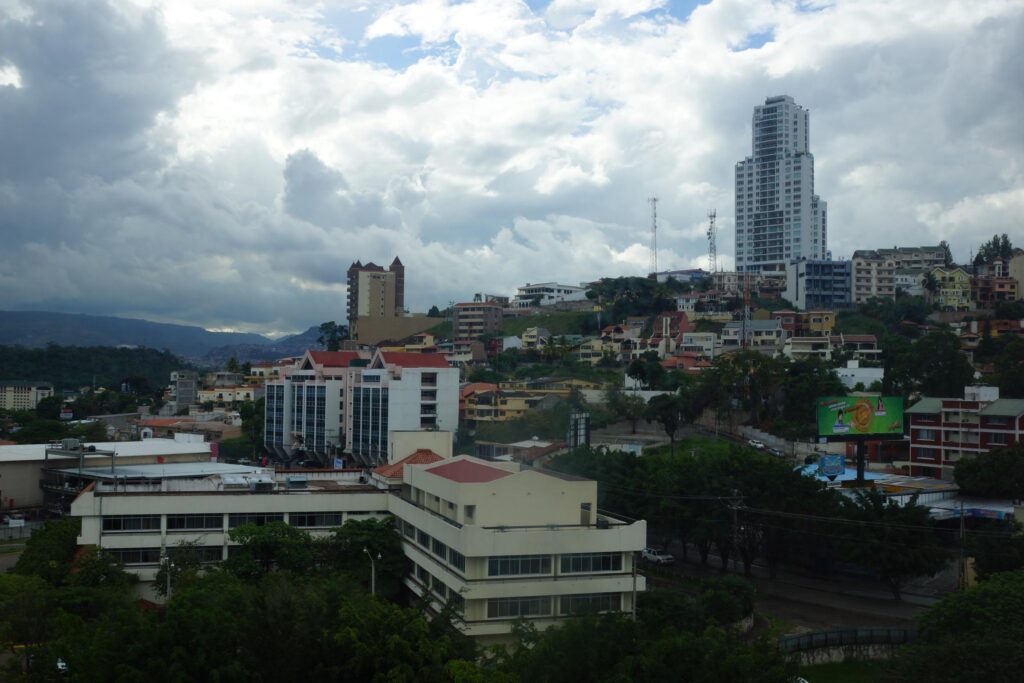In many ways Tegucigalpa is a typical, sprawling Central american metropolis. The streets are often snarled with fume-belching traffic, while the crowds are thick and the pace is frenetic. However, the setting is spectacular- the city is nestled in a valley surrounded by a ring of mountains.
We are still not sure whether we can fly into Tegucigalpa, the capital of Honduras, since the weather there does not look too pretty. An alternate airport would be Managua in Nicaragua. But on the way to the airport we receive good news: it cleared up in Tegucigalpa and so the difficult approach should not be such a problem with our pilots. Yesterday they worked hours to restore the database of the flight management system which makes live a bit easier for them.
At the end of the one hour flight, we have to circle over Tegucigalpa. There clouds are not so dense and the view is not so bad. After circling three times over the airport, Rainer does a superb landing (according to Chief of all Chief Captains Tom Hartmann).
On the ground there are a lot of people expecting us but we really don‘t understand who is in charge of all of them. Finally one of them gets us through customs and immigration but the driver who should take us to the hotel is not around. Nobody speaks English and our handler finally gets somebody from the crowd who speaks English. It turns out he is not really working for handling company; nobody is here from them!! In the meantime two policemen want to check Tom – chaos poor. We start to understand the expression „Banana Republic“; it is really like Africa.
We finally arrive at the hotel and have lunch at TGIF. Memories of the good old hedge fund days in Manhattan come back! The restaurant is located in a shopping mall that could be somewhere in Southern Europe. The shops look top-notch and every thing is clean. Prices are also almost the same like in Europe.
Honduras became an independent nation in 1821 from Spain. After two and a half decades of mostly military rule, a freely elected civilian government came to power in 1982. During the 1980s, Honduras proved a haven for anti-Sandinista contras fighting the Marxist Nicaraguan Government and an ally to Salvadoran Government forces fighting leftist guerillas. The country was devastated by Hurricane Mitch in 1998 , which killed about 5‘600 people and caused approximately USD 2 billion in damage.
is the second biggest country in Central America, about 2 1/2 times the size of Switzerland with around 8 mio. inhabitants. It is the second poorest country in Central America and has an extraordinarily unequal distribution of income and high un- and underemployment. The economy relies heavily on a narrow range of exports, notably apparel, bananas, and coffee, making it vulnerable to natural disasters and shifts in commodity prices. Nearly half of Hondura‘s economic activity is directly tied to the US, with exports to the US equivalent to 30% of GDP and remittances for another 22%.
Legendary football manager Bill Shankly once said: „Some people believe football is a matter of life and death…it is much more important than that.“ Even Mr. Shankly might have balked at Honduras‘ and El Salvador‘s sporting rivalry, which spilled off the pitch and onto the battlefield in the 1969. Guerra de Futbal – the notorious Football War.
Tensions did not suddenly break out on the stadium terraces. In the 1950‘s and 1960‘s, a flagging economy forced 300‘000 Salvadorans to seek better conditions in Honduras. However, the Honduran economy was itself ailing, and Salvadorians began to be targeted as scapegoats. In June 1969, Honduran authorities started throwing Salvadoran immigrants out of the country. A stream of Salvadoran refugees followed, alleging Honduran brutality.
In the same month, the two countries were playing World Cup qualifying matches against each other. At the San Salvador game, Salvadorans attacked Honduran fans, defiling the Honduran flag and mocking the anthem. Across the borders, angry Hondurans, then turned on Salvadoran immigrants. Tempers frayed further and the El Salvador army invaded Honduran territory on 14th July, capturing Nueva Ocotepeque. Hondurans retaliated with air strikes. A ceasefire was called after only six days, but around 2‘000 Hondurans lost their lives, while thousands of Salvadorans fled home.
